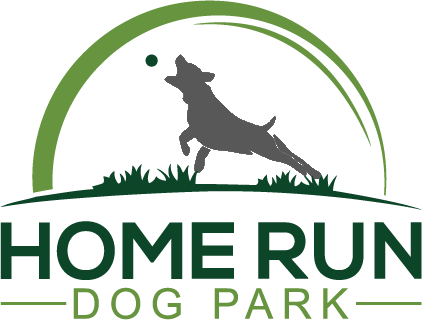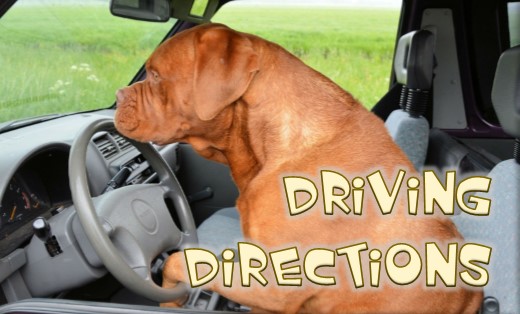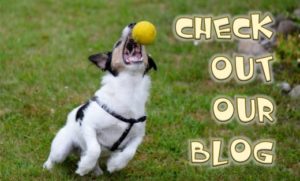
What is the scoop with poop at the Home Run Dog Park? You know, that doggie unmentionable subject that we all deal with? It goes without saying, that every dog poops. So put on your sanitary rubber gloves, and let’s dig into the subject… so to speak.

At the Home Run Dog Park we have four separate waste stations in the main dog area, and one in the small dog area. These stations have individual waste bags, and a trash bin at the base (see photo).
The trash bins at the bottom of these stations are to be used for dog waste only, not regular trash. There are regular trash receptacles at each of the gated entrances and one in the pavilion. Dog waste should never be thrown in the regular trash bins.
The trash is separated in this manner because the dog waste is not picked up by the City. Only the regular trash cans are emptied by the City. The reason for this difference is that the City trash is collected by Waste Management, and they will not collect bags of dog waste.
Instead there is a separate company that the Home Run Dog Park contracts with called the Kalamazoo Poo Crew. You may have seen their name on the sponsor board at the park. They service the dog park on Friday’s weekly during the peak months of warmer weather, and every two weeks during the winter. When they come, they remove and replace the waste canister bags, and refill the individual bag dispensers on top. They also walk the park, and remove any dog waste that they may find be on the ground.

The Home Run Dog Park has posted signs that instruct people to pick up after their own dog. This is an important action to keep the park clean. However, it is always possible to miss seeing your dog doing their business, so it is important that everyone using the park pay attention and alert other dog owners if they happen to miss seeing their dog leaving a deposit.
It is also good protocol that if you come across dog waste, to just pick it up and dispose of it. It may not have been your dog, and is may not be any dog there at the time when you visit that did it, but it helps keep the park clean and healthy for all the dogs.
There are dog waste bag dispensers at each of the waste stations, as mentioned earlier. It is strongly encouraged for owners to bring and carry their own dog waste bags with them when visiting, for three reasons:
- During peak times of park use, the waste station dispensers might be empty as they are only refilled once a week during the summer, and once every two weeks in the winter months.
- Waste station bags are supplied through park donations, and it helps the supply of waste station bags last longer if some of the park users are bringing their own.
- It is much easier to have a waste bag with you, than have to walk to the waste station, and then return to try to find where your dog did his or her business. It is a big dog park, and it is easy to lose track of the location of those little nuggets in the grass.
Dog waste can carry many diseases and bacteria. Here are some common and scary examples:
- Campylobacter, are bacteria that can make people and animals sick with a disease called campylobacteriosis. It is most often spread through feces of infected animals.
- Cryptosporidiosis is a parasitic disease caused by the germ Cryptosporidium (or Crypto for short), which is spread by swallowing poop from an infected person or animal.
- Canine parvovirus is a contagious small virus that that affects the gastrointestinal tract of dogs. In young puppies, it may also damage the heart muscle. Canine parvovirus is commonly referred to as “parvo.” Parvo is spread through the waste of infected dogs by having your dog come in contact with it by touching, sniffing or eating it.
- Echinococcosis is a parasitic disease caused by infection with tiny Echinococcus tapeworms. Dogs shed Echinococcus eggs in their poop. The parasite spreads to people through eating or drinking food or water that is contaminated with the poop of an infected dog, or by touching a dog that has eggs of the parasite in its fur. Dogs become infected by eating tissue of infected sheep or goats.
- Giardia is a parasite found on surfaces or in water, food, or soil that has been contaminated by poop of an infected person or animal, including dogs. Giardia spreads through swallowing microscopic poop containing the parasite following contact with an infected person or animal or by drinking water or eating food that has been contaminated with poop from infected people or animals, including dogs. Dogs with Giardia may have diarrhea, greasy stools or become dehydrated. People with this can experience vomiting, abdonimal discomfort, nausea, gas and diarrhea, or may have no signs of the illness.
- Hookworms are small worms that can spread through contact with contaminated soil or sand. The CDC estimates that there may be as many as 740 million people worldwide that are infected with hookworm, most outside of the USA. It was once widespread in the U.S., primarily in the Southeast, but improved living conditions have greatly reduced the commonality of this infection. There are several species of hookworm. Dogs can be infected by hookworms penetrating their skin or ingesting the parasite from the environment. Also, puppies can be infected before birth or through drinking their mother’s milk or colostrum. People can be infected with hookworms by walking barefoot, kneeling, or sitting on ground that is contaminated with the poop of infected animals.
- Toxocariasis is an infection caused by the roundworm. Roundworms are most commonly found in the intestines of dogs. Dogs shed roundworm eggs in their poop. People and dogs can become infected with roundworms by swallowing roundworm eggs from the environment, such as dirt contaminated with poop. Also, puppies can be infected before birth or through drinking their mother’s milk or colostrum.
- Salmonellosis is caused by Salmonella bacteria, which are most commonly spread through contaminated food. However, Salmonella live in the intestines of people and animals. People and animals can get Salmonella by eating contaminated food, drinking contaminated water, or by touching infected animals, their poop, or contaminated items or surfaces. Dogs and other animals that can carry Salmonella can appear healthy, but still be shedding germs through their dog waste that can make people sick.
Contrary to what some might think, dog waste is not good fertilizer for the lawn. In fact, it is actually toxic and can cause grass to burn or discolor. Beyond the damage it does to grass, it is estimated that a single gram of dog waste can contain 23 million fecal coliform bacteria which are infectious to humans and are known to cause cramps, diarrhea, intestinal illness and serious kidney disorders.
So in managing the Home Run Dog Park, we make a lot of effort to get the dog waste removed regularly, and keep the park clean. However, it takes all of our efforts as a community to maintain the cleanliness. So if you are at the dog park, and you see poop, pick it up, even if you do not know which dog produced the little treasure. It is the healthy thing to do. Also, it’s nice to be able to walk the park without worrying about your shoes getting yucky!

The summer heat can also make the smells worse than in winter, which can attract flies and other insects. So bag those little (or big) unmentionables, and drop them in the waste cannisters! If we all do this, we can continue to keep the park healthy and clean.
So now you know the scoop on poop!








